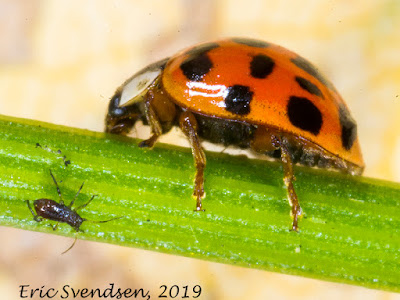Carrion beetle.
 |
| A carrion beetle - Nicrophorus |
Beetles inhabit a tremendous range of niches and display some of the most peculiar behaviours anywhere in the animal kingdom. Many of them are also quite beautiful, although I fully admit that beauty truly lies in the eye of the beholder. One of the prettiest beetles I have ever come across is the carrion beetle.
Carrion beetles, both larvae and adults, feed on the flesh of decomposing organisms. They seek out some dead thing, often a small vertebrate like a mouse, and go about the business of burying it. This represents no small effort given the difference in size. Males that are successful in finding a carcass will attract a mate, copulate, then work together to cover up their find. Eggs are laid and the young and adults both feed on the corpse. What is unusual is that both adults tend the eggs and larvae.
I have found two of these over my time hiking about in the woods. I collected one a couple of years ago and photographed it (above), and this summer I found another. Both had a number of mites on them, the first had only three but the second must have had over twenty. Perhaps there is a relationship between their food of choice and being parasitized by these tiny arachnids.
I used the following website for some of my information: https://www.fws.gov/midwest/endangered/insects/ambb/abb_fact.html
Thanks for reading. www.ericspix.com



Comments
Post a Comment